Soccer drills
- The neutral players stand on the sideline.
- The game is played with pupil goals.
- Defenders can score directly after possession of the ball.
- Attackers must pass over X times.
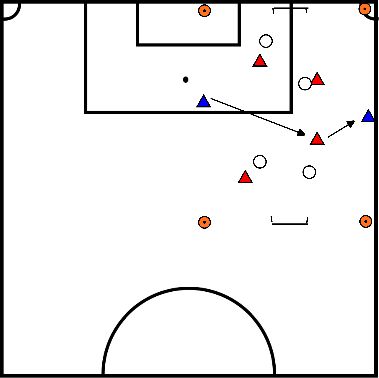
- Handball.
- Long ball.
- Shooting outside the 16.

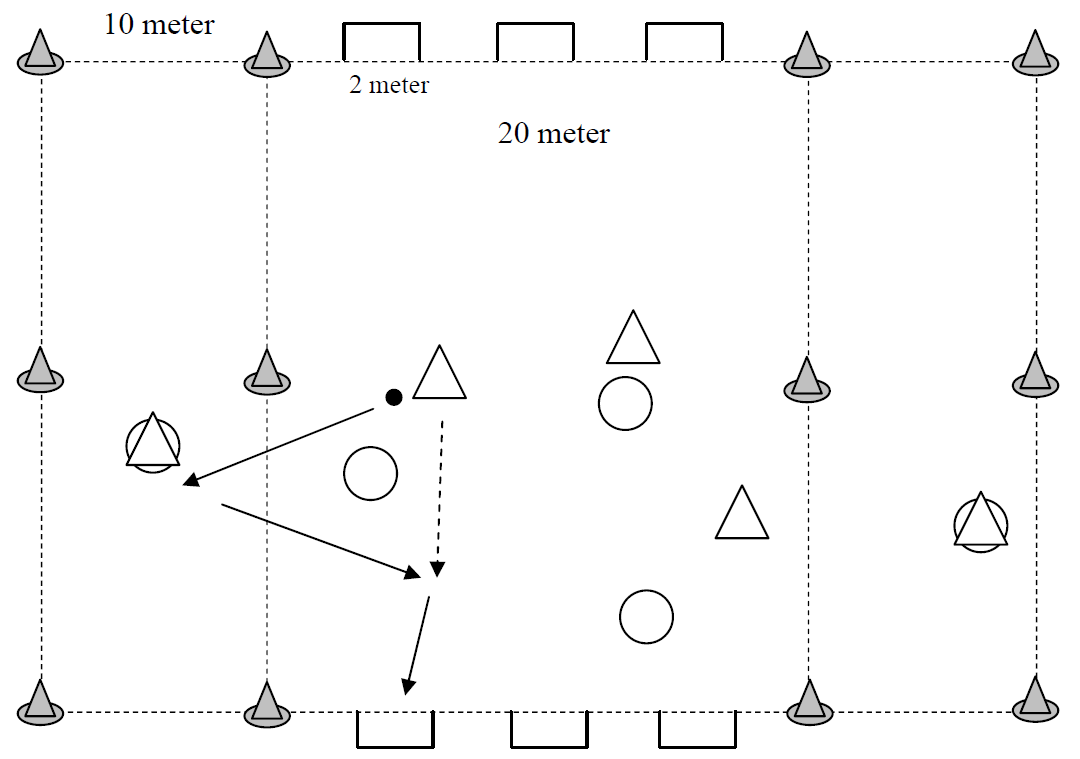
Organisation:
The game is played 3:3 with extra players on the sides, the outfield players. These 2 players are with the ball-carrying team.
Encourage the offside players to play quickly.
The offside players can also dribble with the ball first
After a few minutes, they must either play directly or pass and play
If this is going well, you can also let the two offside players play directly.
The players on the outside are not allowed to score
After 10 minutes or a little less, change the outfielders.
Remarks:
After the offside players have to accept and play, the game runs better. There is
more football in the gamenow
, while in the beginning the outfielders were running a lot with the ball
.
Points of attention:
Try to play directly.
Make sure they use the sides and do not always go for their own success.
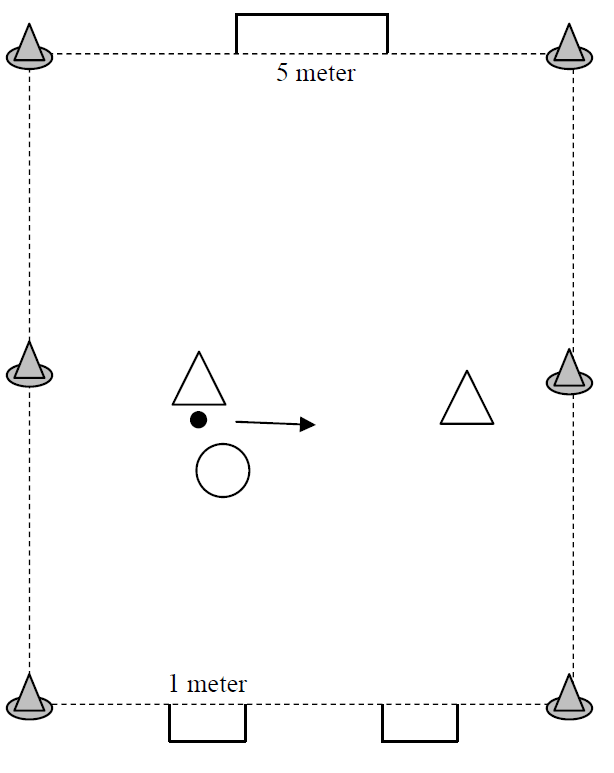
Organization:
The game is played 2 against 1. If there are 2 players left they play 1:1 on a smaller field.
The pair tries to score on the 2 little goals.
After about 8 minutes the players are changed.
If the 2 team has it too easy, you can move the 2 goals closer together.
Remarks:
Because of the many 1:1 duels you can soon see if they are doing well or not so well. Don't
give them instructionsin the first
game. Give them the chance to improve themselves.
Points of attention:
Prevent the opponent from shooting at goal.
Position yourself in such a way that it is difficult for your opponent to pass to his/her team-mate
Organisation:
On 2 fields 3:3, 4:4 or 4:3 is played.
You can score with a dribble through one of the two little goals.
First try to encourage them to make passing moves.
If that is going well, you can also try to make sure they make the right choice between passing and playing over.
After about 10 minutes a different opponent.
Remarks:
When changing opponents, you can indicate which nice passing actions you have seen.
Points of attention:
Do not use the passing move too far or too close to the opponent.
The body must move with the passing move in order for it to be successful.
Organisation:
On 2 or 3 fields play 4:4, 3:3 or 2:2.
Encourage shooting from distance.
Points of attention:
Technical execution of the kick with the inside of the foot
: Stand leg; point in the direction of play; bent at the hip, knee and ankle.
Playing leg; turned outward; knee and ankle bent.
Playing foot; perpendicular to the direction of play; sole of the foot parallel to the ground; toes raised;
no weak ankleon the
kick.
A controlled swinging movement.
Technical execution of the kick with the inside of the instep
:Stand leg; 2 to 3 foot widths next to the ball; bent at the knee.
Tackle; on the inside of the spot where the laces begin.
Approach from an angle of approximately 45º.
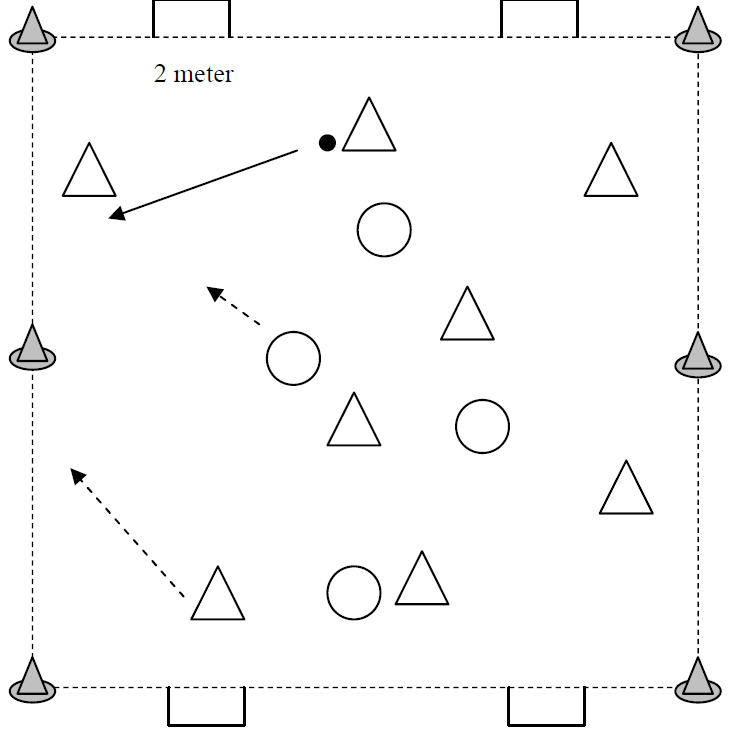
Organisation:
The game will be played 8:4.
6:3, 7:3, 7:4, 9:4 or 9:5 is also possible.
With more or less players the size has to be adjusted.
The 8-team may score after 5 replays.
The 4-player team may always try to score.
When the ball is intercepted by the foursome, when it goes out or after a goal has been scored, a new count must be made.
count again.
After, in total, 5 goals or after 10 minutes substitute.
To make it easier or more difficult, the number of replays can be changed.
Points of attention:
Use the left and right foot.
If possible, keep the ball low
.
Correct ball speed.
Play directly.
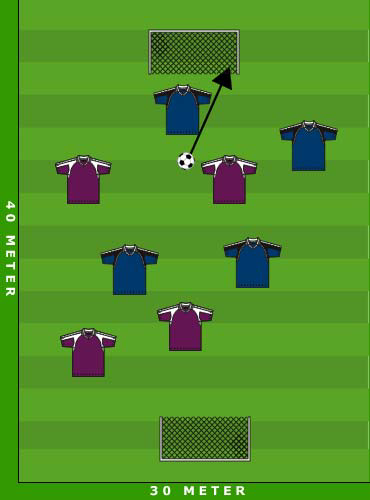
Field setup:
2 large goals
How the game progresses:
This can be done in 4 v 4 or 3 v 3 or even 2 v 2 formation. Players must always pass 1 player before the ball is passed to the teammate.
Rules/tips:
- If there is scored or shot over the line the ball must be given to the other team.
- A goal may not be scored from the team's own half.
- One player must always be passed before a pass can be made. If this is not done, it is a free ball for the other team.

Field position:
1 starting pawn at 30 meters from the goal. A defender at 10 meters from the goal. A goalkeeper on the goal. A second defender with the rising attacker.
Sequence of play:
According to the numbering in the diagram, the pass from the attacker through the midfielder is played deep. The defender runs with the attacker while the midfielder runs towards the goalkeeper to get the ball there and tries to score.
Rules/tips:
- Defenders start at 50% effort and increase it later.
- Make sure the ball is played deep.
- The cross can be hit from the left or from the right.
- A variation on this is to play with 2 midfielders and have 1 run towards the far post.
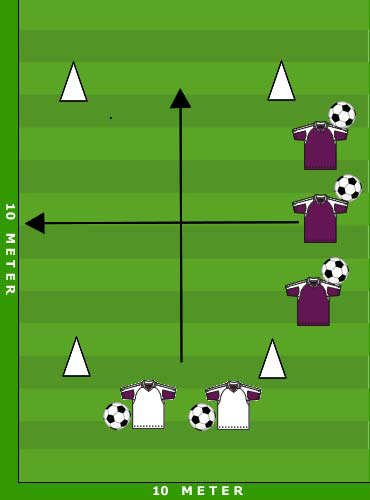
Field setup:
Field set up with 4 pawns at 10 by 10 meters.
How to play:
There are 2 groups made. One group runs horizontally from left to right and the other group from bottom to top. When the other side is reached, the whistle must be blown and the group goes back.
Rules of play:
- You may not hit another player or the player's ball.
- If you hit someone, you and the player you hit get 1 penalty.
- You may not run over until the coach whistles.
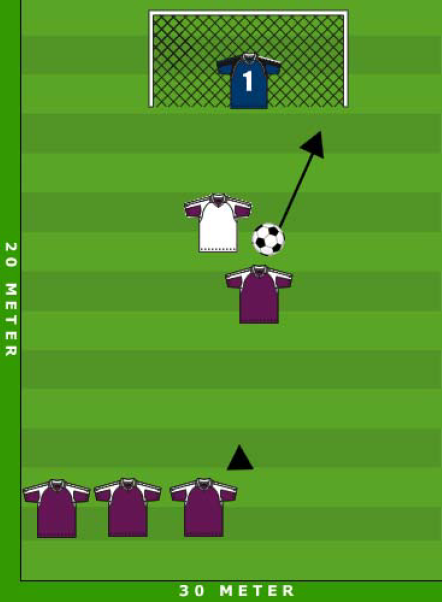
Field position:
1 starting pawn at 30 meters from the goal. A defender at 20 meters from the goal. One goalkeeper on the goal.
How to play:
Player dribbles towards the goal and tries to pass the defender and then score a goal at the goalie.
Rules/tips:
- Only when the first player is finished can the second one, etc.
- Start with 50% defence and increase it later on.
- Try different passing moves.
- Always try to get the ball in front of your shooting foot after the pass.
- For the goalkeeper: only when the attacker has passed the defender should he run out
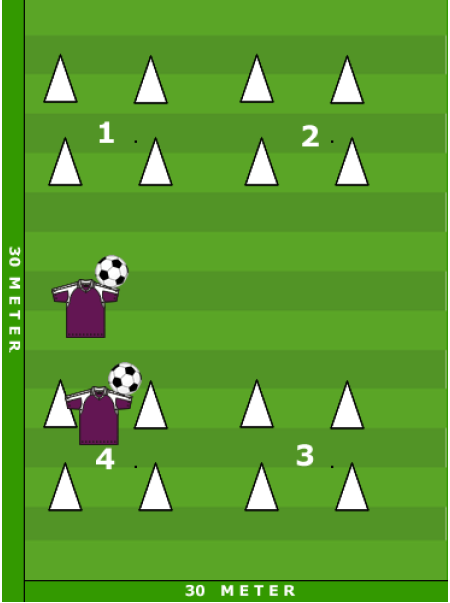
Field setup:
4 x 4 pawns in a rectangle arrangement.
Sequence of play:
At the 1 x whistle, all players run with the ball to square 1, at 2 x whistle to square 2, etc.
Rules of the game:
- The player who gets the ball to the square first gets 1 point.
- The last player to reach the square must sprint around the whole playing field.








